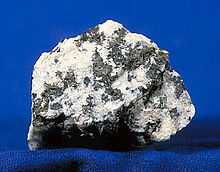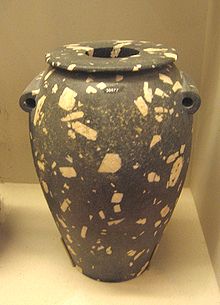- Diorite
-
Diorite (
 /ˈdaɪəraɪt/) is a grey to dark grey intermediate intrusive igneous rock composed principally of plagioclase feldspar (typically andesine), biotite, hornblende, and/or pyroxene. It may contain small amounts of quartz, microcline and olivine. Zircon, apatite, sphene, magnetite, ilmenite and sulfides occur as accessory minerals.[1] It can also be black or bluish-grey, and frequently has a greenish cast. Varieties deficient in hornblende and other dark minerals are called leucodiorite. When olivine and more iron-rich augite are present, the rock grades into ferrodiorite, which is transitional to gabbro. The presence of significant quartz makes the rock type quartz-diorite (>5% quartz) or tonalite (>20% quartz), and if orthoclase (potassium feldspar) is present at greater than ten percent the rock type grades into monzodiorite or granodiorite. Diorite has a medium grain size texture, occasionally with porphyry.
/ˈdaɪəraɪt/) is a grey to dark grey intermediate intrusive igneous rock composed principally of plagioclase feldspar (typically andesine), biotite, hornblende, and/or pyroxene. It may contain small amounts of quartz, microcline and olivine. Zircon, apatite, sphene, magnetite, ilmenite and sulfides occur as accessory minerals.[1] It can also be black or bluish-grey, and frequently has a greenish cast. Varieties deficient in hornblende and other dark minerals are called leucodiorite. When olivine and more iron-rich augite are present, the rock grades into ferrodiorite, which is transitional to gabbro. The presence of significant quartz makes the rock type quartz-diorite (>5% quartz) or tonalite (>20% quartz), and if orthoclase (potassium feldspar) is present at greater than ten percent the rock type grades into monzodiorite or granodiorite. Diorite has a medium grain size texture, occasionally with porphyry.Diorites may be associated with either granite or gabbro intrusions, into which they may subtly merge. Diorite results from partial melting of a mafic rock above a subduction zone. It is commonly produced in volcanic arcs, and in cordilleran mountain building such as in the Andes Mountains as large batholiths. The extrusive volcanic equivalent rock type is andesite.
Contents
Occurrence
Diorite is a relatively rare rock; source localities include Leicestershire; UK[2] (one name for microdiorite - Markfieldite - exists due to the rock being found in the village of Markfield), Sondrio, Italy; Thuringia and Saxony in Germany; Finland; Romania; Northeastern Turkey; central Sweden; Scotland; the Darrans range of New Zealand; the Andes Mountains; the Isle of Guernsey; Basin and Range province and Minnesota in the USA; Idahet in Egypt
An orbicular variety found in Corsica is called corsite.
Historic use
Diorite is an extremely hard rock, making it difficult to carve and work with. It is so hard that ancient civilizations (such as Ancient Egypt) used diorite balls to work granite. Its hardness, however, also allows it to be worked finely and take a high polish, and to provide a durable finished work.
One comparatively frequent use of diorite was for inscription, as it is easier to carve in relief than in three-dimensional statuary. Perhaps the most famous diorite work extant is the Code of Hammurabi, inscribed upon a 2.23m (7ft 4in) pillar of black diorite. The original can be seen today in Paris' Musée du Louvre.[3] The use of diorite in art was most important among very early Middle Eastern civilizations such as Ancient Egypt, Babylonia, Assyria and Sumer. It was so valued in early times that the first great Mesopotamian empire -- the Empire of Sargon of Akkad -- listed the taking of diorite as a purpose of military expeditions.
Although one can find diorite art from later periods, it became more popular as a structural stone and was frequently used as pavement due to its durability. Diorite was used by both the Inca and Mayan civilizations, but mostly for fortress walls, weaponry, etc. It was especially popular with medieval Islamic builders. In later times, diorite was commonly used as cobblestone; today many diorite cobblestone streets can be found in England, Guernsey and Scotland, and scattered throughout the world in such places as Ecuador and China. Although diorite is rough-textured in nature, its ability to take a polish can be seen in the diorite steps of St. Paul's Cathedral, London, where centuries of foot traffic have polished the steps to a sheen.
See also
References
- ^ Blatt, Harvey and Robert J. Tracy (1996) Petrology, W. H. Freeman, 2nd edition, p. 53 ISBN 0-7167-2438-3
- ^ Midland Quarry Products
- ^ The Louvre: Law Code of Hammurabi
Igneous rocks by composition Type Ultramafic
< 45% SiO2Mafic
45-52% SiO2Intermediate
52–63% SiO2Intermediate-Felsic
63–69% SiO2Felsic
>69 % SiO2Volcanic rocks:
Subvolcanic rocks:
Plutonic rocks:Andesite
DioriteCategories:- Granitic rocks
- Intermediate rocks
- Plutonic rocks
Wikimedia Foundation. 2010.




